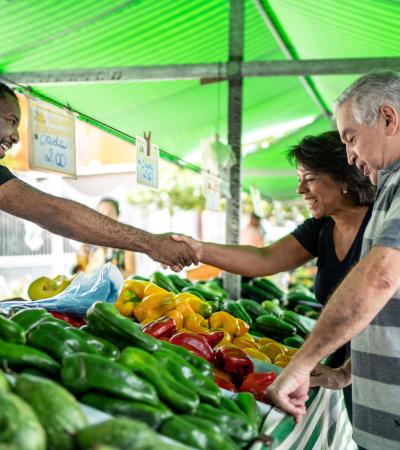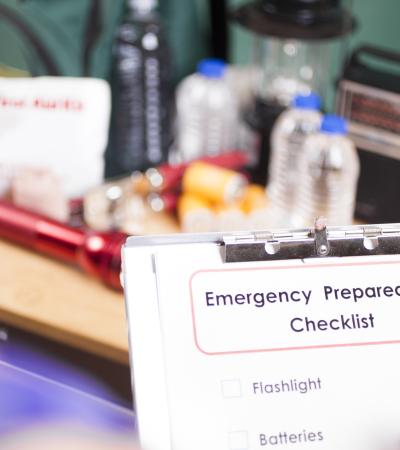To better prepare the community in case of an emergency, the Dallas Public Library prepared a joint library and community disaster preparedness plan. The plan included a one-shelf collection of books at seven branch locations and a one-shelf medical reference collection at three branch locations for the community to use in times of emergency.
We also created a pocket guide that would hold useful disaster preparation information and distributed 25 flash drives with pertinent information for use during a disaster when access to our server might be inhibited.
Advanced Planning
This project was a collaboration between Dallas Public Library, the Office of Emergency Management (OEM) and the University of Texas Southwestern Medical Center Library,
We began our project with the goals of:
- Preparing the community and library system for disasters by producing a planning document;
- Providing a select number of Dallas Office of Emergency Management (OEM) staff and library staff alternative access to this document by purchasing, placing and disseminating these documents on 25 flash drives;
- Supplying Dallas residents with copies of the pocket guide; and
- Adding disaster planning books to seven library locations across the city of Dallas.
We invited representatives of the project's partners to participate in the community gathering to help prepare residents for any disaster events and to launch the community disaster-planning pocket guides. Library staff then distributed the guide to community organizations within their branch communities. The library also included distribution of the pocket guide in its literacy presentations at outreach centers.
The library relied heavily on the expertise of its own staff with experience in researching information about disaster planning, area resources and good medical and disaster reference texts. We formed a committee that included members of the library's Government Information Center to help guide the development of the pocket guide. We also reached out to OEM, and they lent invaluable expertise during all steps of the process and held meetings while staying in almost constant communication with the OEM staff in support of this project at various stages.
Representatives of area disaster relief services supported the project by being involved with the library’s Disaster Preparedness Fairs. Community partners also helped in the distribution of the pocket guides.
Marketing
The target population was the residents of Dallas since they are prone to several disaster risks: flooding, flash flooding and tornados. We reached out to neighborhoods that are particularly vulnerable based on location of local flood planes. We did not limit our focus to any ethnicity or education level, as all citizens are at risk during big weather events.
To promote the guides and the collections, we planned, organized and executed three community Disaster Preparedness Fairs at libraries that had received the grant-related book collections. We worked with our city’s Public Information Office and the Dallas Morning News to push out the story; we also had it on our website and social media.
The best marketing was our staff talking it up at events and having the pocket guides sitting on the check-out desk for people to take (they were printed in English and Spanish).
Budgeting
We received a grant from the National Network of Libraries of Medicine (NNLM) South Central Region. Our $10,000 budget was allocated as follows:
- Disaster planning book collection: $1,386
- Medical reference book collection: $4,164
- Design and printing of the pocket guide: $1,390 (2,000 copies)
- Salary, part-time assistant (60 hours of work): $765
- Flash drives: $1,545
- Community press event: $750
Day-of-event Activity
The library ran into several issues regarding the implementation of this grant.
The library’s original proposal included the purchase of aircards to be used in the event of an emergency, to access the library’s disaster plan on the city’s servers. The aircards proved to be out of budget. Additionally, in the event of an emergency, there would be no guarantee that the city’s servers would be functioning. The library requested and was granted a rebudgeting proposal to change this piece of the grant. Flash drives were purchased, and the library’s disaster plans were uploaded.
The original grant proposed some award for the hiring of part-time assistant to help prepare and desired the pocket guide. The money requested was not enough to do this. We used our own internal staff to produce the document and reassigned the money to produce more pocket guides.
Another part of the original grant money was to be put towards a press conference to bring out the disaster pocket guides and the one-shelf planning collections in the community. Library staff felt that the money would be better spent in the production of more pocket guides. The library sought to use its publicity channels to get television air-time. This turned out to be more difficult than expected, so the library pursued other channels of distribution.
Program Execution
We were able to successfully distribute 7,000 Community Disaster Planning pockets guides to the 29 branch libraries and other community organizations around Dallas, with 2,000 of them in Spanish. We ran into difficulty because at first the printing company told us they could fold the document, but later said they could not. We were able to enlist a cadre of volunteers to fold the 7,000 documents for distribution.
The project was evaluated by the library committee and library administration staff. We looked into the original goals of the project and its subsequent rebudgeting realignments. The group agreed that the major goals were either met or exceeded.
The only portion of the grant award not met was in the area of PR where the library was not able to get television airtime to introduce the grant’s products into the community. However, the Community Disaster Preparedness Fairs were a notable achievement. These went a long way in publicizing the event in a more interactive way that truly engaged the community and other disaster service partners in Dallas in ways that a television appearance never could have. These fairs also set the stage for further disaster preparedness events in the future.
Advice
Anyone considering holding a similar project should look at their own community and determine what kind of disasters you are most prone to and create the most effective plan.
We highly recommend the pocket guide idea. Once distributed, it proved to a lasting way to spread awareness to our entire city about the disaster plan.



